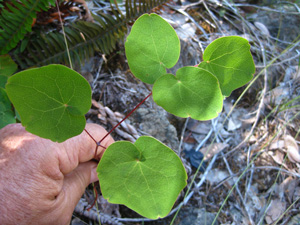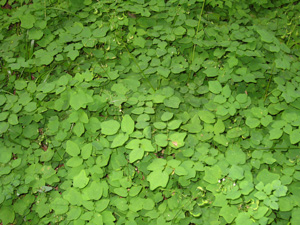Resource Library
Plant of the Week: Inside-Out Flower
The University of Arkansas System Division of Agriculture does not promote, support or recommend plants featured in "Plant of the Week." Please consult your local Extension office for plants suitable for your region.
Plant of the Week
Inside-Out Flower
Latin: Vancouveria sp.

A decade ago, I was bitten by the collecting bug and started gathering in an assortment of barrenworts (Epimediums) from China and Central Asia. This group of 60 or so species attracted my attention because of their reputation for growing in dry shade, of which I have plenty. At that same time, through the collecting efforts of Darrell Probst of Massachusetts, who made several trips into China during the last decade of the 20th century, many new species were being offered in the nursery trade. In the summer of 2011, I was able to inspect the North American counterparts of this group (Vancouveria sp.) in the wild.
Three species of Vancouveria are distributed in the mountains along the Pacific Coast from Washington to northern California. They show close kinship with the Epimediums and have been combined with them by some authorities, but are separated largely because of one glaring difference: the number of petals in the flower.
All three Vancouveria are creeping herbaceous perennials with compound evergreen to semi-evergreen leaves, like many members of the barberry family to which they belong. The evergreen species V. chrysantha and V. planipetala have leathery leaves with rounded but lobed leaflets to 2 inches across. V. hexandra, which tends to be more deciduous than evergreen, has bi-pinnately compound leaflets that are strongly lobed. All three species produce foliage 6 to 12 inches tall, with the width of the colony depending on age and the characteristics of the site. V. hexandra is the strongest grower, but requires more moist conditions than the other two species. Epimediums have a similar leaflet arrangement and structure, but barrenwort leaflets have a strongly offset leaflet base and the tips of the leaflets come to a spear-shaped point.

The main difference separating these two genera is the number of petals in the flower. For Epimedium, all flowers are four-merous, meaning there are four petals, four sepals and four nectary glands. In Vancouveria the flowers are six-merous and white, except for V. chrysantha, which is yellow. The flowers are borne on a 12 to 16 inch tall, multi-flowered scape in late spring or early summer. The petals and sepals of Vancouveria are bent backwards (reflexed) with the six stamens and the pistol strongly exerted, thus giving rise to the common name of inside-out flower. The seed pods and seeds of Vancouveria and Epimedium are similar and consist of ½ inch-long bean-shaped pods.
That the North American inside-out flowers are closely related to but now distinct from the Epimediums of Asia is due to the geographic separation that has occurred over the past 30 or 40 million years. Fossil records show that much of Asia and North America shared a common flora all the way from Greenland in the east to China in the west. As continents shifted on their respective plates and the northern latitudes got colder, this flora began retreating to more hospitable climes. I speculate that a number of species of Epimediums were left behind on this side of the Pacific. Over the millions of generations since the continents went their separate ways, the survivors retreated to a habitat most like the milder middle period of the Cenozoic.
Six-merous flowers are very unusual in plant families. Monocots are based on three-petal arrangements, while most dicot families have either 4 or 5 petals. Six petals, as found in the Vancouveria, is an aberration to the norm and reflects a trait being perpetuated across the millennia as the gene pool developed in isolation.
Vancouveria are not commonly offered in the nursery trade, though those who have grown them proclaim them to be as easily grown as the Epimediums. All are said to be winter-hardy from zones 5 through 8. They should be grown in a well-drained but reasonably fertile woodland site with afternoon shade. The most often listed species, V. hexandra, is reported to be the least drought-tolerant of the three, while V. chrysantha, the least available species, is said to be the most drought-tolerant. After seeing these species in the wild, I will begin seeking them out to add to my growing collection.
By: Gerald Klingaman, retired
Retired Extension Horticulturist - Ornamentals
Extension News - September 9, 2011
The University of Arkansas System Division of Agriculture does not maintain lists of retail outlets where these plants can be purchased. Please check your local nursery or other retail outlets to ask about the availability of these plants for your growing area.